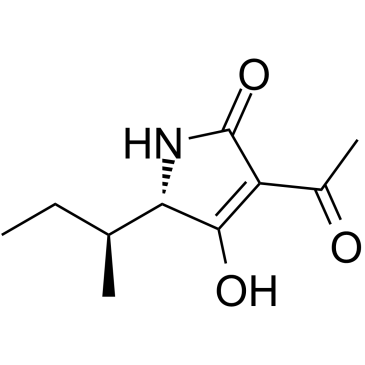Tenuazonic acid-(Copper salt)

Tenuazonic acid-(Copper salt) structure
|
Common Name | Tenuazonic acid-(Copper salt) | ||
|---|---|---|---|---|
| CAS Number | 610-88-8 | Molecular Weight | 197.231 | |
| Density | 1.2±0.1 g/cm3 | Boiling Point | 401.1±45.0 °C at 760 mmHg | |
| Molecular Formula | C10H15NO3 | Melting Point | 74.5°C | |
| MSDS | Chinese USA | Flash Point | 196.4±28.7 °C | |
| Symbol |

GHS06 |
Signal Word | Danger | |
|
Natural occurrence of four Alternaria mycotoxins in tomato- and citrus-based foods in China.
J. Agric. Food Chem. 63(1) , 343-8, (2015) A total of 70 tomato-based and 86 citrus-based products collected in China were analyzed for alternariol, alternariol monomethyl ether, tentoxin, and tenuazonic acid by ultraperformance liquid chromatography–electrospray ionization–tandem mass spectrometry. N... |
|
|
Evaluation of analogs of reutericyclin as prospective candidates for treatment of staphylococcal skin infections.
Antimicrob. Agents Chemother. 53 , 4028-31, (2009) The potential for reutericyclin derivatives to be used as topical antibiotics to treat staphylococcal skin infections was investigated. All reutericyclins inhibited the growth of clinical isolates of drug-resistant Staphylococcus aureus. Unlike the standard t... |
|
|
Effects of nisin and reutericyclin on resistance of endospores of Clostridium spp. to heat and high pressure.
Food Microbiol. 34(1) , 46-51, (2013) The effects of high pressure, temperature, and antimicrobial compounds on endospores of Clostridium spp. were examined. Minimal inhibitory concentrations (MIC) of nisin and reutericyclin were determined for vegetative cells and endospores of Clostridium sporo... |
|
|
In situ determination of Clostridium endospore membrane fluidity during pressure-assisted thermal processing in combination with nisin or reutericyclin.
Appl. Environ. Microbiol. 79(6) , 2103-6, (2013) This study determined the membrane fluidity of clostridial endospores during treatment with heat and pressure with nisin or reutericyclin. Heating (90°C) reduced laurdan (6-dodecanoyl-2-dimethylaminonaphthalene) general polarization, corresponding to membrane... |
|
|
Mycotoxin production by Alternaria strains isolated from Argentinean wheat.
Int. J. Food Microbiol. 119(3) , 219-22, (2007) The toxigenic potential of Alternaria strains isolated from Argentinean wheat was investigated. A total of 123 strains were assayed for the production of tenuazonic acid (TA), alternariol (AOH) and alternariol monomethyl ether (AME). All but one of the isolat... |
|
|
Identification of tenuazonic acid as a novel type of natural photosystem II inhibitor binding in Q(B)-site of Chlamydomonas reinhardtii.
Biochim. Biophys. Acta 1767(4) , 306-18, (2007) Tenuazonic acid (TeA) is a natural phytotoxin produced by Alternaria alternata, the causal agent of brown leaf spot disease of Eupatorium adenophorum. Results from chlorophyll fluorescence revealed TeA can block electron flow from Q(A) to Q(B) at photosystem ... |
|
|
AFLP variability, toxin production, and pathogenicity of Alternaria species from Argentinean tomato fruits and puree.
Int. J. Food Microbiol. 145(2-3) , 414-9, (2011) Large amounts of tomato fruits and derived products are produced in Argentina and may be contaminated by Alternaria toxins. Limited information is available on the genetic variability, toxigenicity, and pathogenicity of Alternaria strains occurring on tomato.... |
|
|
Reutericyclin and related analogues kill stationary phase Clostridium difficile at achievable colonic concentrations.
J. Antimicrob. Chemother. 66(8) , 1773-6, (2011) The stationary phase of Clostridium difficile, which is associated with the symptoms of the diarrhoeal disease, is refractory to antibiotic killing. The aim of this study was to explore whether probiotic-derived reutericyclin and related synthetic analogues c... |
|
|
Alternaria toxins in wheat during the 2004 to 2005 Argentinean harvest.
J. Food Prot. 71(6) , 1262-5, (2008) The natural occurrence of Alternaria mycotoxins in Argentinean wheat from the zone 5 South during the 2004 to 2005 harvest was investigated in 64 wheat samples. All samples were highly contaminated with a wide range of fungal species. Alternaria was found as ... |
|
|
Enzyme immunoassay for tenuazonic acid in apple and tomato products.
J. Agric. Food Chem. 59(23) , 12317-22, (2011) The Alternaria mycotoxin tenuazonic acid was derivatized with succinic anhydride and conjugated to keyhole limpet hemocyanin (KLH) and to horseradish peroxidase (HRP), respectively. The KLH conjugate was used to produce polyclonal antibodies in rabbits. A com... |